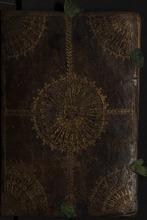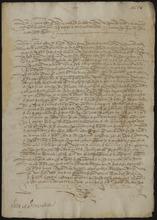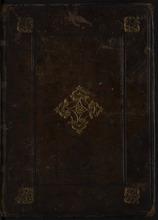1 - 4 of 4 records
Carta executoria de hidalguía for Diego Zamorano Duarte and Pedro Zamorano Duarte of Leganés

Description: Binding: tooled leather over boards with remnants of green silk ties. Green silk guard sheets for illuminations,Illumination: f 2r: Border and top third. Initial D with rose and goldfinch. "Don Phillipe" [Philip III] in gilt. F 3v: border and coat of arms.nSigned "Yo, el Rey" [I, the King] with wax seal affixed,Measurements: 30.5 cm x 21.8 cm
Member of: Cartas Ejecutorias
Resource Type: Text
Carta ejecutoria de hidalguia a pedimento de Don Garcia de Hoz

Description: Stiff-board and leather binding, decorated with gilded details (at the center, the last name "Oz"). Coat of arms in folio 1v. and another miniature on folio 3r. 28.5 x 19.5 cm
Member of: Congressional Research Service
Resource Type: Text
Power of attorney to sell a Spanish Vineyard in 1496.

Description: Document written on paper, in which Alonso Pérez de Cuerva gives his power of attorney to his brother Pedro Fernández de Cuerva to sell a vineyard that he owns. The land's general location and its specific neighboring vineyards are given. Very good condition, light waterstain in inner margins. Written in a standard public notorial hand. Dated: Madrid, 30 May 1496. One folio, 31 x 22 cm.
Member of: Private Collection of Antiquarian Books and Manuscripts
Resource Type: Text
Rituals of the Burgundian Court under Charles the Bold

Description: "4to (21 x 15 cm). Manuscript on paper, written on both sides of the leaves in brown ink in a single hand. Contemporary tanned goatskin, gold- and blind-tooled.(37), (11 blank) ll.A sixteenth-century manuscript, the first two thirds (48 pp.) being an unpublished Spanish translation of the rituals of the Burgundian Court under Charles the Bold (1433-1477), first written down by Olivier de la Marche (1426-1501) in his chronicle around 1492. From the present document it appears to have been translated into Spanish in 1546, before Marche's chronicle was published (in French as Les Memoires , Lyon, 1561). The Holy Roman Emperor Charles V may have had the translation made at Venice for his son, the future King Philip II of Spain (1527-1598), Duke of Milan since 1540. Philip had married Mary of Portugal in 1543, and Charles was already planning his succession to the Spanish crown by 1546 (he was officially declared Charles's successor in 1549), so Philip would need to set up his own court and could base the Court rituals on those of Charles the Bold. The last third of the manuscript (26 pp.) lists wages, etc., paid in January 1546 by the Emperor Charles V, to a variety of courtiers and other officials at "Sumag[um?]" (Venice?) listed by their titles: "Breve Relacion de los Gages Pensiones, y Libreas Hordinarias q[ue?]llevan y toman [or loman?] del Emperador los Señores, Grandes, Segun y otros Chanberlanes [sic], ... y otros oficiales de sumag[um]. contados porsus acroyes y libras de despensa, hordinarias fechaeño tre que, estando ay sumag[um]. en el mes de henero. 1546 años."The manuscript is made from a single paper stock, with at least some and probably all of the endpapers from the same stock. It collates A-E8 [F]8, with the signatures in the upper right corner of the first page of each gathering. The translation of Marche's text occupies fols. A1r-C8v, the list of wages C8v-E5v, and the rest is blank except for a pen flourish on F8v. The paper is watermarked: -- = simple Latin cross on an inverted-teardrop shield, above "EM." Briquet shows a virtually identical mark (5688), found in Perpignon in 1596, and mentions a similar one used in Milan in 1600. The present manuscript is therefore a transcription made around the time of Philip II's death in 1598, of the translation of Marche's text and the list of wages originally made in 1546. In the heading to the list of wages, the writer appears to have first mistakenly transcribed the date as 1576 and corrected it to 1546.With the owner's signature of Sir Richard Fanshawe, Royalist diplomat who helped negotiate the marriage of Charles II with the Spanish Infanta, and an armorial bookplate of John Fanshaw of Parsloes, Essex (since Sir Richard's only surviving son Richard had no heirs, the family arms and this manuscript passed to a side branch). Richard Fanshawe (1608-1666) lived in Madrid in the 1630s where he served as secretary to the British ambassador to Spain, and he may have acquired this manuscript there. He returned to Spain briefly in 1650 and was ambassabor to Portugal and then Spain in the years 1662 to 1666.In very good condition, with only a small marginal worm hole in the last leaves, not approaching the text, and some light waterstains, occasionally touching the text. Binding slightly rubbed and head and foot of backstrip lacking. A sixteenth-century manuscript of unpublished texts throwing light on the establishment of the future King Philip II's court at Madrid.",Full pdf available, https://dl.mospace.umsystem.edu/mu/islandora/object/mu%3A445609/datastream/PDF/view
Member of: Private Collection of Antiquarian Books and Manuscripts
Resource Type: Text